The FileInputStream operates on the local disk file system relative to the working directory and knows absolutely nothing about the fact that it's invoked from a Java EE web application. Any relative path you pass to it is relative to the folder which was been opened at the moment the command to start the server is executed. This is often the server's own installation folder, but in case of an IDE this can also be project's own root folder. This variable is not controllable from inside your Java code. You should not be relying on that.
You've stored the file as a resource of the public webcontent. So it's available as a webcontent resource by ServletContext#getResourceAsStream() which returns an InputStream. If you have absolutely a legitimate reason to invoke the servlet by its URL instead of just using the file's own URL http://localhost:8080/ServletExample/OpenMe.xls, then you should be getting at as follows:
InputStream input = getServletContext().getResourceAsStream("/OpenMe.xls");
// ...
If your intent is indeed to restrict the file's access to by the servlet only, you might want to consider to move the file into the /WEB-INF folder, so that the enduser can never open it directly by entering the file's own URL. You only need to change the resource path accordingly.
InputStream input = getServletContext().getResourceAsStream("/WEB-INF/OpenMe.xls");
// ...
You should not be using getRealPath() as suggested by the other answer. This won't work when the servletcontainer is configured to expand the WAR file into memory instead of into local disk file system, which is often the case in 3rd party hosts. It would return null then.
See also:
